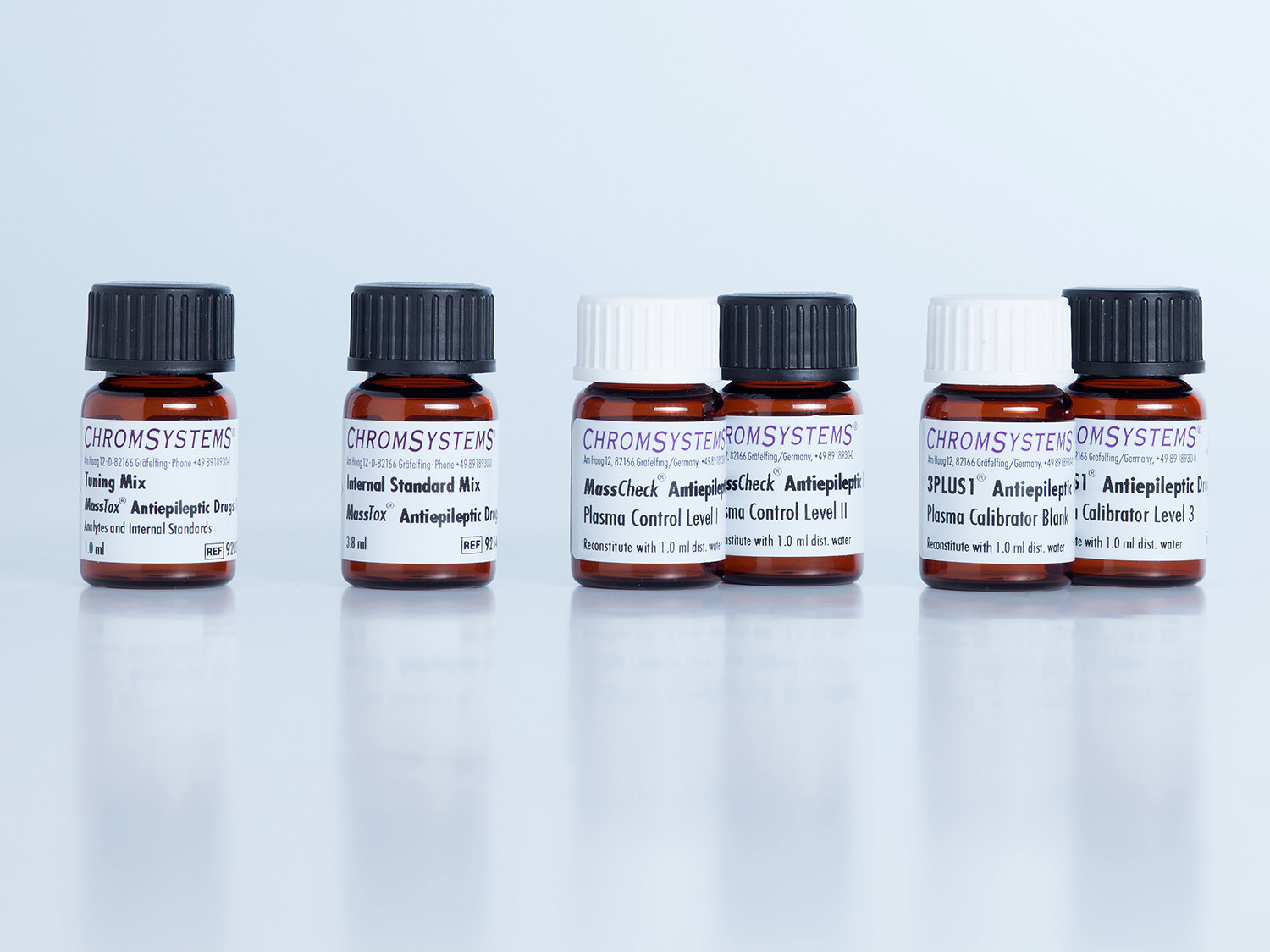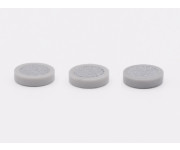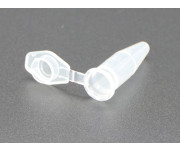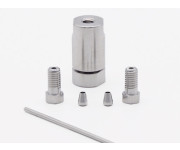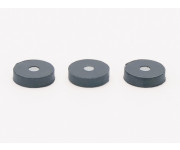Parameter Set Antiepileptic Drugs All-in-One Method - LC-MS/MS
Determination of all 29 analytes in a single run
With 26 internal standards
Part of the MassTox® TDM Series A
CE-IVD validated product ready for IVDR within timeframes and transition periods specified by the IVDR 2017/746
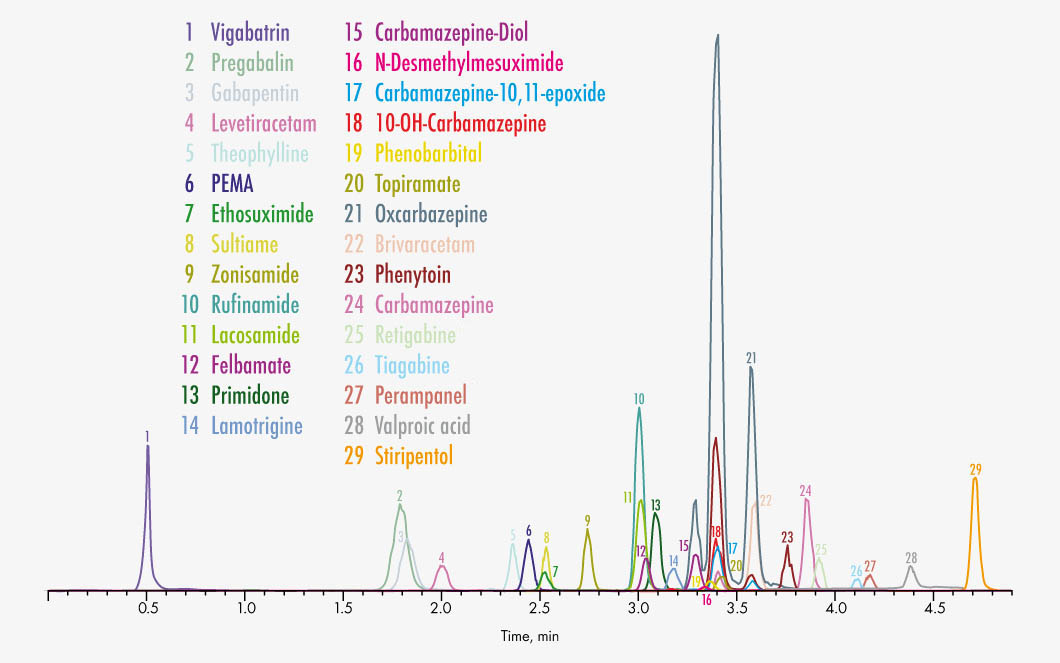

Brivaracetam
Carbamazepine
Carbamazepine-10,11-epoxide
10,11-Dihydroxycarbamazepine
10-OH-Carbamazepine
Ethosuximide
Felbamate
Gabapentin
Lacosamide
Lamotrigine
Levetiracetam (Keppra®)
N-Desmethylmesuximide
Oxcarbazepine
Perampanel
Phenobarbital
Phenylethylmalonamide (PEMA)
Phenytoin
Pregabalin
Primidone
Retigabine
Rufinamide
Stiripentol
Sultiame
Theophylline
Tiagabine
Topiramate
Valproic acid
Vigabatrin
Zonisamide
Clinical relevance
Epileptic seizures are the result of synchronous discharges of neuron groups in the brain that can lead to sudden and involuntary stereotypical behavioural or sensory disorders. Numerous types of seizures have been described, each of which requires specialised therapy. The probability of them occurring depends on a number of factors. In addition to genetic predisposition, it is primarily exogenous factors that are relevant, such as accident, thrombosis, tumours or meningitis. Therapy with anticonvulsive medication (antiepileptics) leads to a reduction in seizures and sometimes even a complete elimination of seizures in most treated patients. The precondition for the antiepileptics to have a therapeutic effect is usually patient compliance, which means regular use of the medication. Thus, monitoring of the blood levels is essential, especially during initial dose setting.
Product advantages
- Also including brivaracetam, perampanel, retigabine
- Determination of all analytes in a single run
- With 26 internal standards
With the Parameter Set Antiepileptic Drugs in serum/plasma, 29 different drugs can be measured quickly and efficiently using LC-MS/MS. Due to the careful optimisation of all kit components as well as the chromatographic separation, matrix effects (“ion suppression”) are minimised and the robustness of the method is enhanced. Sample preparation is based on a protein precipitation step. The use of stable isotopically labelled (deuterated) and co-eluting internal standards as well as 3PLUS1® multilevel calibrators ensures high precision and the reproducible and reliable quantification of the analytes. The method is comprehensively validated.
The Parameter Set is a part of the Series A modular system, which enables the analysis of all parameters without switching column or changing the mobile phases, thereby minimising required workload in the laboratory. The Basic Kit A contains all components required for sample preparation and all necessary mobile phases. The MasterColumn® A is the analytical column used for the determination of all Series A analytes. Our portfolio contains further MassTox® Parameter Sets.
For the analysis you require the MassTox® TDM Basic Kit A, the specific MassTox® TDM Parameter Set and the analytical column MassTox® TDM MasterColumn® A.
| Method of Analysis | LC-MS/MS |
|---|---|
| Please note | The freely available information on this website, in particular on the sample preparation, are not sufficient to work with our products. Please read instructions and warning notices on products and/or instruction manuals. |
| Lower Limit of Quantitation | 0.004 – 9 mg/l |
| Upper Limit of Quantification | up to 0.50 – 275 mg/l |
| Intraassay | CV < 10 % |
| Interassay | CV < 13 % |
| Recovery | 84 – 118 % |
| Sample Preparation |
|
| Run Time | 4.9 min |
| Injection Volume | 0.2 – 30 µl |
| Gradient | binary |
| Ionisation | ESI positive and negative |
| MS/MS Mode | MRM |
| Additional Info | This method further includes 26 internal standards, which are not shown in the chromatogram for clarity. To avoid ESI switching, the analysis of ethosuximide, phenobarbital and valproic acid can be performed separately in ESI negative mode. |
| Parameters | 10,11-Dihydroxycarbamazepine, 10-OH-Carbamazepine, Brivaracetam, Carbamazepine, Carbamazepine-10,11-epoxide, Ethosuximide, Felbamate, Gabapentin, Lacosamide, Lamotrigine, Levetiracetam (Keppra®), N-Desmethylmesuximide, Oxcarbamazepine, Perampanel, Phenobarbital, Phenylethylmalonamide (PEMA), Phenytoin, Pregabalin, Primidone, Retigabine, Rufinamide, Stiripentol, Sultiame, Theophylline, Tiagabine, Topiramate, Valproic Acid, Vigabatrin, Zonisamide |
-
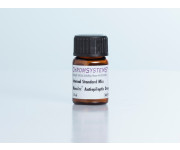 Internal Standard Mix Antiepileptic Drugs/EXTENDEDOrder no.: 92546/XTComponent of the Parameter Set Antiepileptic Drugs All-in-One Method, available separately
Internal Standard Mix Antiepileptic Drugs/EXTENDEDOrder no.: 92546/XTComponent of the Parameter Set Antiepileptic Drugs All-in-One Method, available separately -
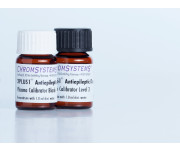 3PLUS1® Multilevel Plasma Calibrator Set Antiepileptic Drugs/EXTENDEDOrder no.: 92025/XTMassTox® TDM Series A Antiepileptic Drugs in Serum/Plasma – LC-MS/MS
3PLUS1® Multilevel Plasma Calibrator Set Antiepileptic Drugs/EXTENDEDOrder no.: 92025/XTMassTox® TDM Series A Antiepileptic Drugs in Serum/Plasma – LC-MS/MS -
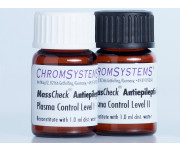 MassCheck® Antiepileptic Drugs/EXTENDED Plasma ControlsOrder no.: 0249/XT; 0250/XT; 0251/XT
MassCheck® Antiepileptic Drugs/EXTENDED Plasma ControlsOrder no.: 0249/XT; 0250/XT; 0251/XTMassTox® TDM Series A Antiepileptic Drugs in Serum/Plasma – LC-MS/MS
-
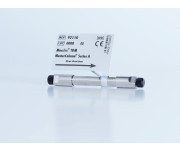 MassTox® TDM MasterColumn® AOrder no.: 92110
MassTox® TDM MasterColumn® AOrder no.: 92110Analytical column for MassTox® TDM Series A - LC-MS/MS
-
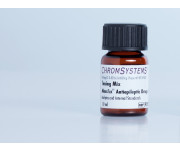 Tuning Mix Antiepileptic Drugs/EXTENDED 1Order no.: 92034/XTTuning Mix 1 for the Parameter Sets Antiepileptic Drugs - LC-MS/MS
Tuning Mix Antiepileptic Drugs/EXTENDED 1Order no.: 92034/XTTuning Mix 1 for the Parameter Sets Antiepileptic Drugs - LC-MS/MS -
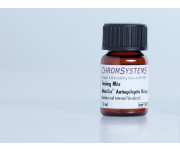 Tuning Mix Antiepileptic Drugs/EXTENDED 2Order no.: 92035/XTTuning Mix 2 for the Parameter Sets Antiepileptic Drugs - LC-MS/MS
Tuning Mix Antiepileptic Drugs/EXTENDED 2Order no.: 92035/XTTuning Mix 2 for the Parameter Sets Antiepileptic Drugs - LC-MS/MS -
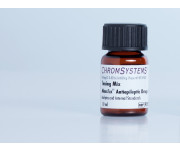 Tuning Mix Antiepileptic Drugs/EXTENDED 3Order no.: 92036/XTTuning Mix 3 for the Parameter Sets Antiepileptic Drugs - LC-MS/MS
Tuning Mix Antiepileptic Drugs/EXTENDED 3Order no.: 92036/XTTuning Mix 3 for the Parameter Sets Antiepileptic Drugs - LC-MS/MS -
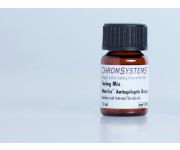 Tuning Mix Antiepileptic Drugs/EXTENDED 4Order no.: 92037/XTTuning Mix 4 for the Parameter Sets Antiepileptic Drugs - LC-MS/MS
Tuning Mix Antiepileptic Drugs/EXTENDED 4Order no.: 92037/XTTuning Mix 4 for the Parameter Sets Antiepileptic Drugs - LC-MS/MS -
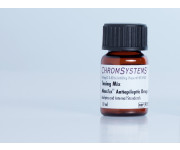 Tuning Mix Antiepileptic Drugs/EXTENDED 5Order no.: 92038/XTTuning Mix 5 for the Parameter Sets Antiepileptic Drugs - LC-MS/MS
Tuning Mix Antiepileptic Drugs/EXTENDED 5Order no.: 92038/XTTuning Mix 5 for the Parameter Sets Antiepileptic Drugs - LC-MS/MS -
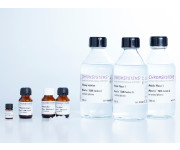 Basic Kit A for 200 Tests - LC-MS/MSOrder no.: 92111/200
Basic Kit A for 200 Tests - LC-MS/MSOrder no.: 92111/200Part of the MassTox® TDM Series A
Modular system for therapeutic drug monitoring
Provides all components required for sample prep and all mobile phasesCE-IVD validated product ready for IVDR within timeframes and transition periods specified by the IVDR 2017/746
-
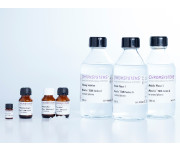 Basic Kit A for 1000 Tests - LC-MS/MSOrder no.: 92111/1000
Basic Kit A for 1000 Tests - LC-MS/MSOrder no.: 92111/1000Part of the MassTox® TDM Series A
Modular system for therapeutic drug monitoring
Provides all components required for sample prep and all mobile phasesCE-IVD validated product ready for IVDR within timeframes and transition periods specified by the IVDR 2017/746
-
 3PLUS1® Multilevel Plasma Calibrator Set Antiepileptic Drugs/EXTENDEDOrder no.: 92025/XTMassTox® TDM Series A Antiepileptic Drugs in Serum/Plasma – LC-MS/MS
3PLUS1® Multilevel Plasma Calibrator Set Antiepileptic Drugs/EXTENDEDOrder no.: 92025/XTMassTox® TDM Series A Antiepileptic Drugs in Serum/Plasma – LC-MS/MS
-
 MassCheck® Antiepileptic Drugs/EXTENDED Plasma ControlsOrder no.: 0249/XT; 0250/XT; 0251/XT
MassCheck® Antiepileptic Drugs/EXTENDED Plasma ControlsOrder no.: 0249/XT; 0250/XT; 0251/XTMassTox® TDM Series A Antiepileptic Drugs in Serum/Plasma – LC-MS/MS


Brivaracetam
Carbamazepine
Carbamazepine-10,11-epoxide
10,11-Dihydroxycarbamazepine
10-OH-Carbamazepine
Ethosuximide
Felbamate
Gabapentin
Lacosamide
Lamotrigine
Levetiracetam (Keppra®)
N-Desmethylmesuximide
Oxcarbazepine
Perampanel
Phenobarbital
Phenylethylmalonamide (PEMA)
Phenytoin
Pregabalin
Primidone
Retigabine
Rufinamide
Stiripentol
Sultiame
Theophylline
Tiagabine
Topiramate
Valproic acid
Vigabatrin
Zonisamide
Clinical relevance
Epileptic seizures are the result of synchronous discharges of neuron groups in the brain that can lead to sudden and involuntary stereotypical behavioural or sensory disorders. Numerous types of seizures have been described, each of which requires specialised therapy. The probability of them occurring depends on a number of factors. In addition to genetic predisposition, it is primarily exogenous factors that are relevant, such as accident, thrombosis, tumours or meningitis. Therapy with anticonvulsive medication (antiepileptics) leads to a reduction in seizures and sometimes even a complete elimination of seizures in most treated patients. The precondition for the antiepileptics to have a therapeutic effect is usually patient compliance, which means regular use of the medication. Thus, monitoring of the blood levels is essential, especially during initial dose setting.
Product advantages
- Also including brivaracetam, perampanel, retigabine
- Determination of all analytes in a single run
- With 26 internal standards
With the Parameter Set Antiepileptic Drugs in serum/plasma, 29 different drugs can be measured quickly and efficiently using LC-MS/MS. Due to the careful optimisation of all kit components as well as the chromatographic separation, matrix effects (“ion suppression”) are minimised and the robustness of the method is enhanced. Sample preparation is based on a protein precipitation step. The use of stable isotopically labelled (deuterated) and co-eluting internal standards as well as 3PLUS1® multilevel calibrators ensures high precision and the reproducible and reliable quantification of the analytes. The method is comprehensively validated.
The Parameter Set is a part of the Series A modular system, which enables the analysis of all parameters without switching column or changing the mobile phases, thereby minimising required workload in the laboratory. The Basic Kit A contains all components required for sample preparation and all necessary mobile phases. The MasterColumn® A is the analytical column used for the determination of all Series A analytes. Our portfolio contains further MassTox® Parameter Sets.
For the analysis you require the MassTox® TDM Basic Kit A, the specific MassTox® TDM Parameter Set and the analytical column MassTox® TDM MasterColumn® A.
| Method of Analysis | LC-MS/MS |
|---|---|
| Please note | The freely available information on this website, in particular on the sample preparation, are not sufficient to work with our products. Please read instructions and warning notices on products and/or instruction manuals. |
| Lower Limit of Quantitation | 0.004 – 9 mg/l |
| Upper Limit of Quantification | up to 0.50 – 275 mg/l |
| Intraassay | CV < 10 % |
| Interassay | CV < 13 % |
| Recovery | 84 – 118 % |
| Sample Preparation |
|
| Run Time | 4.9 min |
| Injection Volume | 0.2 – 30 µl |
| Gradient | binary |
| Ionisation | ESI positive and negative |
| MS/MS Mode | MRM |
| Additional Info | This method further includes 26 internal standards, which are not shown in the chromatogram for clarity. To avoid ESI switching, the analysis of ethosuximide, phenobarbital and valproic acid can be performed separately in ESI negative mode. |
| Parameters | 10,11-Dihydroxycarbamazepine, 10-OH-Carbamazepine, Brivaracetam, Carbamazepine, Carbamazepine-10,11-epoxide, Ethosuximide, Felbamate, Gabapentin, Lacosamide, Lamotrigine, Levetiracetam (Keppra®), N-Desmethylmesuximide, Oxcarbamazepine, Perampanel, Phenobarbital, Phenylethylmalonamide (PEMA), Phenytoin, Pregabalin, Primidone, Retigabine, Rufinamide, Stiripentol, Sultiame, Theophylline, Tiagabine, Topiramate, Valproic Acid, Vigabatrin, Zonisamide |
-
 Internal Standard Mix Antiepileptic Drugs/EXTENDEDOrder no.: 92546/XTComponent of the Parameter Set Antiepileptic Drugs All-in-One Method, available separately
Internal Standard Mix Antiepileptic Drugs/EXTENDEDOrder no.: 92546/XTComponent of the Parameter Set Antiepileptic Drugs All-in-One Method, available separately -
 3PLUS1® Multilevel Plasma Calibrator Set Antiepileptic Drugs/EXTENDEDOrder no.: 92025/XTMassTox® TDM Series A Antiepileptic Drugs in Serum/Plasma – LC-MS/MS
3PLUS1® Multilevel Plasma Calibrator Set Antiepileptic Drugs/EXTENDEDOrder no.: 92025/XTMassTox® TDM Series A Antiepileptic Drugs in Serum/Plasma – LC-MS/MS -
 MassCheck® Antiepileptic Drugs/EXTENDED Plasma ControlsOrder no.: 0249/XT; 0250/XT; 0251/XT
MassCheck® Antiepileptic Drugs/EXTENDED Plasma ControlsOrder no.: 0249/XT; 0250/XT; 0251/XTMassTox® TDM Series A Antiepileptic Drugs in Serum/Plasma – LC-MS/MS
-
 MassTox® TDM MasterColumn® AOrder no.: 92110
MassTox® TDM MasterColumn® AOrder no.: 92110Analytical column for MassTox® TDM Series A - LC-MS/MS
-
 Tuning Mix Antiepileptic Drugs/EXTENDED 1Order no.: 92034/XTTuning Mix 1 for the Parameter Sets Antiepileptic Drugs - LC-MS/MS
Tuning Mix Antiepileptic Drugs/EXTENDED 1Order no.: 92034/XTTuning Mix 1 for the Parameter Sets Antiepileptic Drugs - LC-MS/MS -
 Tuning Mix Antiepileptic Drugs/EXTENDED 2Order no.: 92035/XTTuning Mix 2 for the Parameter Sets Antiepileptic Drugs - LC-MS/MS
Tuning Mix Antiepileptic Drugs/EXTENDED 2Order no.: 92035/XTTuning Mix 2 for the Parameter Sets Antiepileptic Drugs - LC-MS/MS -
 Tuning Mix Antiepileptic Drugs/EXTENDED 3Order no.: 92036/XTTuning Mix 3 for the Parameter Sets Antiepileptic Drugs - LC-MS/MS
Tuning Mix Antiepileptic Drugs/EXTENDED 3Order no.: 92036/XTTuning Mix 3 for the Parameter Sets Antiepileptic Drugs - LC-MS/MS -
 Tuning Mix Antiepileptic Drugs/EXTENDED 4Order no.: 92037/XTTuning Mix 4 for the Parameter Sets Antiepileptic Drugs - LC-MS/MS
Tuning Mix Antiepileptic Drugs/EXTENDED 4Order no.: 92037/XTTuning Mix 4 for the Parameter Sets Antiepileptic Drugs - LC-MS/MS -
 Tuning Mix Antiepileptic Drugs/EXTENDED 5Order no.: 92038/XTTuning Mix 5 for the Parameter Sets Antiepileptic Drugs - LC-MS/MS
Tuning Mix Antiepileptic Drugs/EXTENDED 5Order no.: 92038/XTTuning Mix 5 for the Parameter Sets Antiepileptic Drugs - LC-MS/MS -
 Basic Kit A for 200 Tests - LC-MS/MSOrder no.: 92111/200
Basic Kit A for 200 Tests - LC-MS/MSOrder no.: 92111/200Part of the MassTox® TDM Series A
Modular system for therapeutic drug monitoring
Provides all components required for sample prep and all mobile phasesCE-IVD validated product ready for IVDR within timeframes and transition periods specified by the IVDR 2017/746
-
 Basic Kit A for 1000 Tests - LC-MS/MSOrder no.: 92111/1000
Basic Kit A for 1000 Tests - LC-MS/MSOrder no.: 92111/1000Part of the MassTox® TDM Series A
Modular system for therapeutic drug monitoring
Provides all components required for sample prep and all mobile phasesCE-IVD validated product ready for IVDR within timeframes and transition periods specified by the IVDR 2017/746
-
 3PLUS1® Multilevel Plasma Calibrator Set Antiepileptic Drugs/EXTENDEDOrder no.: 92025/XTMassTox® TDM Series A Antiepileptic Drugs in Serum/Plasma – LC-MS/MS
3PLUS1® Multilevel Plasma Calibrator Set Antiepileptic Drugs/EXTENDEDOrder no.: 92025/XTMassTox® TDM Series A Antiepileptic Drugs in Serum/Plasma – LC-MS/MS
-
 MassCheck® Antiepileptic Drugs/EXTENDED Plasma ControlsOrder no.: 0249/XT; 0250/XT; 0251/XT
MassCheck® Antiepileptic Drugs/EXTENDED Plasma ControlsOrder no.: 0249/XT; 0250/XT; 0251/XTMassTox® TDM Series A Antiepileptic Drugs in Serum/Plasma – LC-MS/MS

